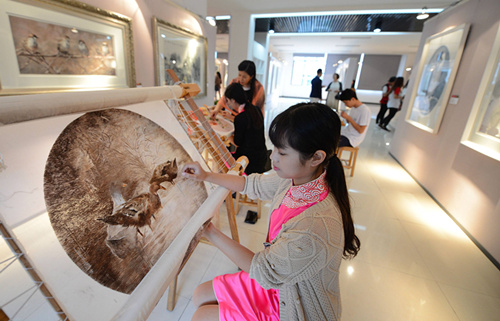Artistic innovation adds vitality to Hunan embroidery techniques
Author : MING HAIYING Source : Chinese Social Sciences Today 2017-06-21

Students from the Hunan Arts and Crafts Vocational College make Hunan embroidery at an innovative embroidery exhibition held on campus.
Hunan embroidery is a form of traditional handicraft from Hunan Province that flourished due to specialized folk embroidery techniques. The techniques involved in Hunan embroidery have a long history and were once commonly used in everyday life. Quilts, clothes, pouches and other household items are all regularly used as subjects for exquisite embroidery patterns. However, the pressures of market economy combined with a shift toward mechanized production have posed difficulties for the preservation of Hunan embroidery.
Development history
Li Xiangshu, an associate professor of the Design Art Institute at Hunan University of Commerce, said that the designs used in Hunan embroidery depend on their different uses in daily life. In terms of sacrificial offerings, the most common design pattern in Hunan embroidery is the “Eight Immortals” of Taoism in Chinese folklore. In terms of various household items, including door curtains, the design patterns used in Hunan embroidery are based on well-known auspicious stories, such as “the carp jumps over the dragon gate” and “Kai Lin sends the children.”
“Hunan embroidery formed a unique style at the end of the Qing Dynasty and truly gained its name at that time,” Li said. In the 1920s and 1930s, the development of Hunan embroidery entered a golden age. Hunan embroidery also absorbed the essence of Suzhou embroidery. As the years went by, professional painters and even famous artists were engaged in designing Hunan embroidery, and these handicrafts gradually transformed into “embroidery painting,” a rich art form. Li said that the biggest historical trend that shaped embroidery painting—the combination of Hunan embroidery and painting—came about due to a transition from simply tracing ancient calligraphy and painting to directly drawing on the embroidery draft designs. The modern form of Hunan embroidery broke various boundaries. Embroidery painting replaced paintbrushes with needles, and utilizes colorful threads to polish the draft designs, which not only preserves the original charm of painting, but also adds a stereoscopic effect.
New Hunan embroidery
Since the reform and opening-up, the Hunan Embroidery Research Institute has aimed to satisfy market demand and explore innovations while following traditions. Li elaborated by saying that the institute draws inspiration from ancient Chinese culture and national culture. He said that it utilizes folk embroidery stitching methods along with traditional Hunan embroidery stitching and the techniques of Tujia brocade and batik from western Hunan Province. This created the “embroidery brocade” and the “embroidery batik” styles which have earned a positive reputation in art circles.
In recent years, the Hunan Arts and Crafts Vocational College established the Art and Design School of Hunan Embroidery which exerted great effort to foster innovation in this art form. The school has enhanced embroidery draft techniques, stitching methods and materials in order to create a new style of Hunan embroidery. Tang Liqun, the dean of the school, said that the creators of the new Hunan embroidery style inherited traditional themes and stitching methods and used these to refine classical elements of Hunan embroidery and apply those elements into ornaments of costumes, crafts and industrial products. They experimented with new materials, creating hair embroidery and linen embroidery.
Talent training
Li indicated that many Hunan embroidery skills were created by several generations of Hunan embroidery masters. Achieving proficiency in those stitch methods requires long-term study. Machine production cannot produce such exquisite works. Cultivating talent and training professionals has become the biggest obstacle in the inheritance and development of Hunan embroidery.
A staff member from the Hunan Embroidery Research Institute said that we should cultivate embroidery talent from an early age, and the institute has already begun to seek cooperation opportunities with local colleges to train young people.
Ye Shengtao made Chinese fairy tales from a wilderness
Ye Shengtao (1894–1988) created the first collection of fairy tales in the history of Chinese children’s literature...
-
How northern ethnicities integrated into Chinese nation
2023-09-18
-
Mogao caves
2023-09-12
-
Mogao Grottoes as ‘a place of pilgrimage’
2023-09-12
-
Time-honored architectural traditions in China
2023-08-29
-
Disentangling the civilizational evolution of China
2023-08-28
-
AI ethics in science fiction
2023-08-23














 2011-2013 by www.cssn.cn. All Rights Reserved
2011-2013 by www.cssn.cn. All Rights Reserved